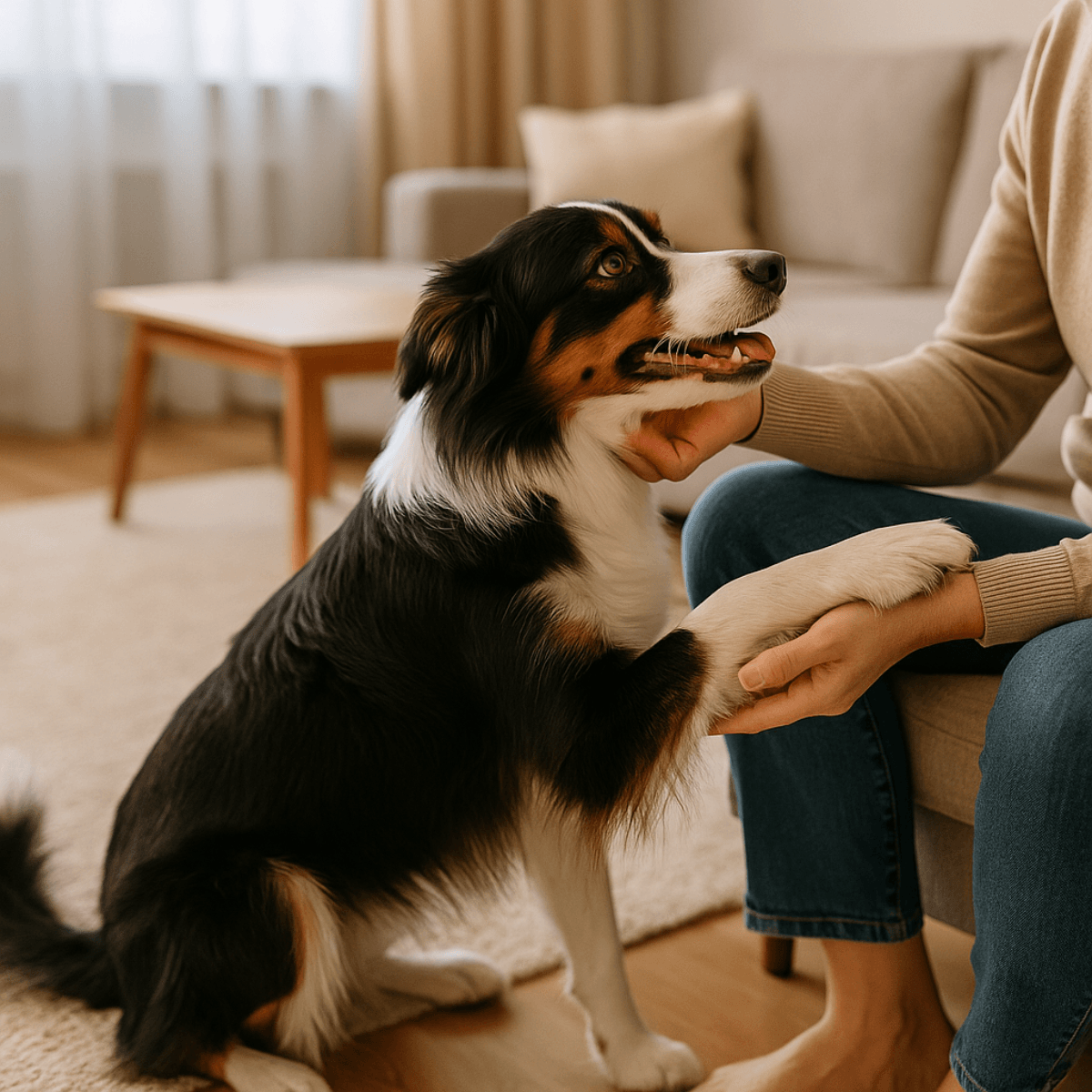
🐶 How to Train Your Dog to Stay Home Alone? A Practical Step-by-Step Guide
For many owners, leaving their dog home alone is associated with anxiety—and rightly so, as not every dog copes well with loneliness right away. Howling, barking, destroying objects, and even self-mutilation are just some of the possible reactions to separation anxiety.
However, the ability to stay home alone isn't a talent, but a learned skill. It requires time, patience, and well-planned training. Understanding your dog's emotions and recognizing stress signals early are crucial to avoiding more serious behavioral problems in the future.
In this guide, we present proven methods, based on behaviorist recommendations and scientific research, that will help your dog build a sense of security and peace while you are away.
It's not just comfort for your pet—it's also peace and confidence for you. With patience, consistency, and a few proven techniques, you can teach your pet to be calm while you're away.
🧠 Why doesn't my dog want to be left alone?
As a domesticated species, dogs have evolved in close cooperation with humans. The bond with their owners is as important to them as contact with other dogs. The absence of this presence can trigger stress reactions comparable to separation anxiety in children.
A study published in the Journal of Veterinary Behavior (2014) found that approximately 20% of dogs exhibit signs of stress and anxiety when left alone at home, including vocalization, destruction of objects, or relieving themselves in unusual places. Dogs are social animals – being around people is a natural need for them. When left alone, they may experience:
- Separation anxiety – excessive attachment and fear of being alone. This can manifest itself through barking, howling, destroying things, or urinating in the house.
- Boredom and frustration – a lack of stimulation and stimuli results in destructive behavior or apathy. Dogs without a job will seek it out on their own – sometimes at the expense of furniture and other objects.
- Anxiety and insecurity – especially in dogs who have been adopted, been through a rough patch, or moved to a new home. For them, any change is a potential threat.
"Separation anxiety is not 'malice', but an emotional reaction of the dog that does not understand why the owner is disappearing"
Additionally, some dog breeds, such as German Shepherds, Border Collies, Poodles, Maltese, and Cavalier King Charles Spaniels, are more prone to separation anxiety due to their high intelligence, sensitivity, and strong need for human closeness.
Dogs adopted from shelters may also be at greater risk – the change in environment and the trauma of abandonment can exacerbate the stress of loneliness. It's also worth remembering that in puppies, separation anxiety may stem from a lack of experience with being alone, while in older dogs, it may arise due to age-related behavioral changes (e.g., cognitive dysfunction syndrome).
The first step is to understand the cause of the problem. Only then can you choose the appropriate strategy—based on empathy, systematic training, and the right environment.
😟 What is separation anxiety in dogs?
🔬 Scientific note : In more serious cases of separation anxiety, combining behavioral training with pharmacological treatment—including medications like clomipramine or fluoxetine—may be effective, according to research published in the Journal of Veterinary Behavior ( ScienceDirect ). Always consult your veterinarian.
Separation anxiety is one of the most common behavioral disorders in dogs. It manifests as intense stress and difficulty coping with the absence of their owner. Some dogs react by crying, barking, or howling, while others destroy objects or try to escape from the home. According to the ASPCA , separation anxiety can be caused by:
- weaning too quickly,
- lack of loneliness training during the socialization period,
- trauma related to abandonment,
- frequent changes of residence or caregivers,
- a strong bond with one person.
Separation anxiety isn't a whim or disobedience—it's a real emotional issue that requires support. Dogs with this disorder aren't "acting out of spite"; they're fighting panic.
Typical symptoms of separation anxiety:
More symptoms according to the ASPCA : refusal to eat, drooling, intense pacing, escape attempts (e.g. scratching the door), self-mutilation (biting paws).
- intense vocalization (howling, barking),
- damaging furniture or doors,
- salivation, tremors,
- escape attempts,
- relieving oneself at home despite having learned to be clean,
- loss of appetite in the owner's absence.
If you suspect your dog is suffering from separation anxiety, it's worth consulting a behaviorist or veterinarian. In some cases, pharmacological support can also be helpful as part of behavioral therapy.
Before beginning systematic training, it's important to provide your dog with the right environment and implement activities that will reduce stress. The key to success is building positive associations with moments of solitude and creating a safe environment.
1. Create a safe space
- Designate a quiet, predictable place in the house for your dog: a bed, a mat, a corner with favorite toys.
- Use the Petto Osaka Fluffy bed : its soft structure and anti-stress properties support relaxation.👉 See the bed
- For smaller dogs, it is worth considering additional steps (e.g. Takai ) that will make it easier to access familiar comfort zones, such as the couch.
2. Introduce calming rituals
- Before a planned absence, it is worth taking care of physical activity – a walk, obedience training or a sniffing game.
- Calm goodbyes (without petting or excessive excitement) help the dog cope better with the moment of separation.
- The owner's scent (e.g. a left-behind sweatshirt) can have a calming effect on the dog – especially in the first stages of learning.
3. Toys and activities for times of solitude
- Kongs , sniffing mats and interactive toys allow your dog to focus on something enjoyable.
- Well-chosen chews (e.g. natural, hard) reduce stress and tension in the jaw muscles.
- Background sound (radio, white noise, calm classical music) can drown out outside sounds and give your dog a greater sense of calm.
4. Introduce solitude gradually and consistently
- Start with minutes, not hours. Even 30 seconds of solitude can be an intense experience for a dog.
- Build positive associations – each successful session should end with a reward (treat, praise).
- If stress occurs, take a step back and shorten the separation time. Overexertion can discourage your dog and worsen anxiety.
Well-planned preparation makes subsequent training not only easier but, above all, more effective. It's the foundation for working on your dog's independence.

🎯 Loneliness Training – Step by Step
Desensitization and counterconditioning training is considered the most effective way to teach a dog to stay home alone. According to the American Veterinary Society of Animal Behavior (AVSAB), this method—which gradually acclimates a dog to stress-inducing stimuli—allows for lasting changes in the animal's emotional responses.
The process can take anywhere from a few days to several months, depending on the dog's anxiety level and previous experiences. The key is to monitor stress signals (e.g., panting, yawning, vocalization) and adjust the pace of progress to the individual capabilities of the dog.
🔁 Stages of effective training:
- Start with presence training – teach your dog to rest in one place, such as a bed, when you're nearby. Commands like "place" or "stay" are helpful.
- Remove yourself for short periods of time – go to another room, return a moment later, and praise your dog for remaining calm. Practice this several times a day.
- Simulate leaving the house – put on your shoes, grab your keys, open the door, but return before your dog reacts with stress. Repeat this step several times.
- Extend the time away – when your dog can tolerate a few minutes, start extending the time: 5, 10, 20 minutes. Don't rush it – if stress appears, take a step back.
- Vary your routine and the elements of your outings – sometimes go out with a backpack, other times without shoes. This helps avoid over-associating certain stimuli with separation.
- Make sure your dog calms down emotionally upon returning – don't greet him with excessive enthusiasm. Wait until he's calmed down, then reward him with calm contact.

📌 Expert tips:
- Training should not take place when the dog is tired or hungry – conditions must be conducive to concentration.
- It's a good idea to keep a progress journal to notice changes in your dog's behavior.
- If your dog is showing symptoms of severe separation anxiety (destroying objects, self-harming, vocalizing for many minutes) – consider consulting a behaviorist.
🐕 Products that help with loneliness training
- 🐾 Petto Osaka Fluffy Bed – a comfortable and anti-stress place to relax👉 See the bed
- 🧗♂️ Takai Steps – make it easier for your dog to access their comfort zone, e.g. their favorite couch👉 See Takai Steps
- 🍖 Chew toys, stuffed toys and sniffing mats – they help your dog relax and keep him occupied when he's alone
⚠️ What to avoid?
Some intuitive human behaviors can actually exacerbate a dog's loneliness and perpetuate its anxiety. Here are the most common mistakes to avoid:
- Punishing a dog upon return – dogs don't understand the connection between their actions and their owner's reaction after a period of time. Reprimanding them for chewed objects, for example, only increases stress and can make the dog fearful of your return.
- Excessive goodbyes and greetings can intensify the emotional stress of separation. It's recommended to ignore your dog for a few minutes before leaving and after returning. Only when he's calmed down should he be rewarded with gentle contact.
- Extending alone time too quickly – if the dog hasn't mastered shorter stages, further increasing the distance can lead to reversal of progress. Training should proceed at the dog's pace, not the owner's.
- Failure to observe stress signals —panting, yawning, nose-licking, pacing, or vocalization—are symptoms that indicate a dog is emotionally overloaded. Ignoring them leads to the problem escalating.
- Leaving your dog in an empty, devoid of stimulation room – the loneliness of silence and emptiness intensifies the feeling of isolation. It's worth leaving something that smells of your owner, playing soft music, or providing a toy with food.
"Trying to teach solitude too quickly can have the opposite effect – the dog will start to associate every moment of being left alone with increasing stress"
Avoiding these mistakes and observing your dog with empathy is the basis for effective and safe solitude training.
📌 Summary
Solitude is a difficult but attainable skill, especially if we approach it with empathy and awareness of a dog's emotional needs. Instead of demanding instant readiness from a dog, it's worth investing time in building positive associations and supporting them in the adaptation process.
According to Pet Behavior Science , an individual approach and gradual increase in distance are key to successful training. Good equipment – such as an anti-stress bed, scent mats, and a proper routine – can significantly improve training effectiveness.
It's also important to avoid common mistakes: extending alone time too quickly, saying goodbye excessively, or punishing the dog upon returning. All of these can reverse the effects and worsen the problem. Some dogs will recover more quickly, while others will need more time and specialist support.
Regardless, the pace should be adjusted to the animal's emotional capabilities. Remember: patience, routine, and consistency are the keys to success. And good equipment—like a comfortable bed or toys for alone time—makes this process much easier. Your dog can be left alone—and you can have peace of mind, knowing you've left him in comfort, safety, and a stress-free environment.
❓ FAQ – most frequently asked questions about dog loneliness
How long can a dog be left home alone?
A healthy adult dog can typically be left alone for 4–6 hours. A maximum of 8 hours is recommended, but with proper training. Puppies and seniors require more frequent visits from their caregiver.
Can any dog learn to be left alone?
Most dogs do. The key is patient training and an individualized approach. Dogs with separation anxiety require more time and specialist support.
What to do if your dog barks or howls when you are away?
This is a sign of stress. It's worth recording your dog (e.g., on a camera) and analyzing where the tension appears. Then, take a step back in training.
Which breeds are most prone to separation anxiety?
Very intelligent and sociable breeds, such as Border Collies, Sheepdogs, Poodles, Maltese, and Cavalier King Charles Spaniels, often experience loneliness more acutely.
Should a dog have access to the entire apartment while you are away?
Not always. For many dogs, it's better to confine their space to a familiar, quiet spot. This provides a sense of security.
Does leaving the radio or music on really help?
Yes, calming classical music or white noise can reduce stress and calm your dog. It also acts as part of a routine.
Are there apps or devices that help a lonely dog?
Yes – including cameras with voice function, remote-controlled interactive toys, olfactory mats, and treat dispensers.
Can you leave your dog with another dog?
The presence of another dog can help, but it doesn't always solve the problem. Separation anxiety usually affects the person, not the fact of being alone.
See more at: Petto.com.pl












































 https://petto.com.pl
https://petto.com.pl